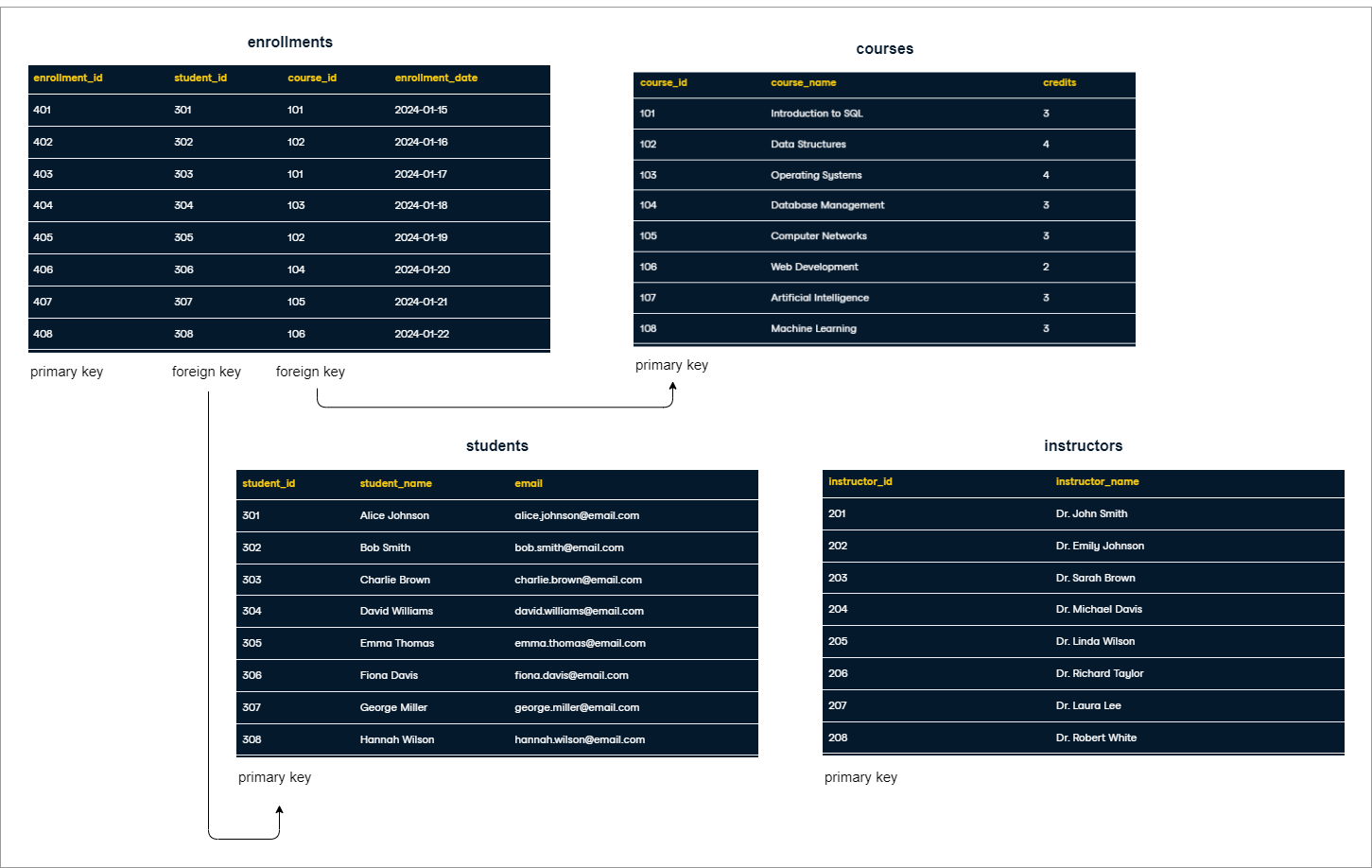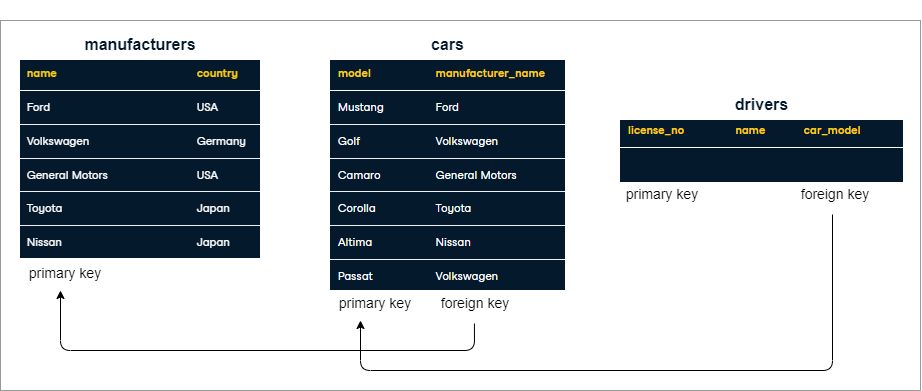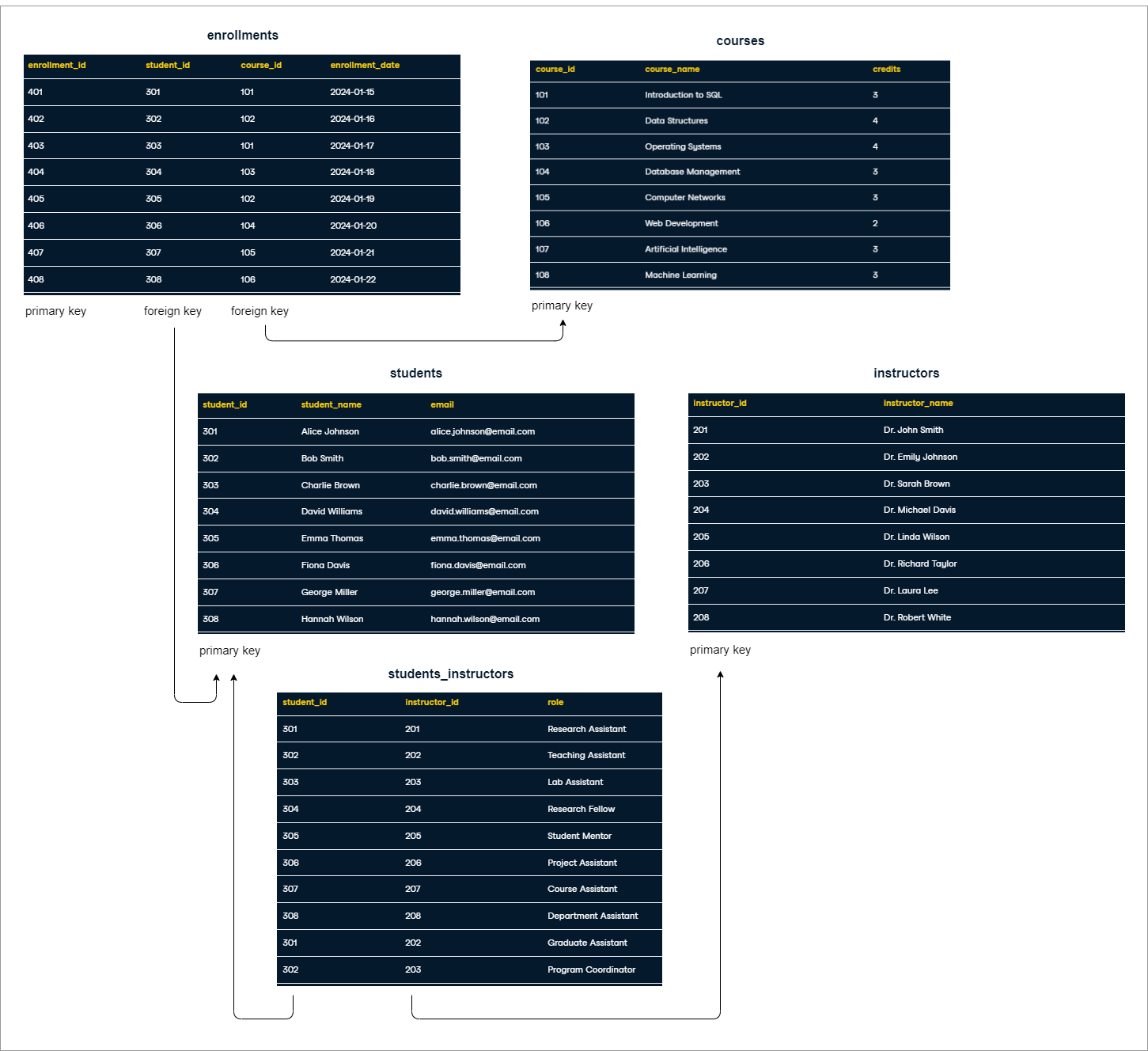Foreign Keys
Sample Tables A
This is the first set of tables that will be used in the examples in this guide. These tables will be created in the succeeding sections below.

Each student can enroll in multiple courses, and each course can have multiple students enrolled in it. This many-to-many relationship is represented in the diagram below with a rhombus, showing the cardinality: a student can be enrolled in zero or more courses, and a course can have zero or more students.

Sample Tables B
This is the second set of tables that will be used in the examples in this guide. These tables will be created in the succeeding sections below.

Foreign Keys
To implement the relationships between the tables, we can use foreign keys. Foreign keys are columns that point to the primary key of another table. There are important rules for foreign keys:
-
Domain and Data Type Consistency
- The domain and data type must match the primary key's type.
-
Referential Integrity
- Foreign key values must exist in the primary key of the referenced table.
- This ensures that all entries in the foreign key column correspond to existing entries in the primary key column.
-
Duplicates and Nulls
- Foreign keys are not actual keys, it can have duplicates and null values, unlike primary keys.
Foreign Keys in New Tables
When creating a new table, you can specify a foreign key similarly to a primary key. We can create the first table and specify the first column as the primary key.
CREATE TABLE table_a (
column_a1 VARCHAR(255) PRIMARY KEY,
column_a2 VARCHAR(255)
);
For the second table, we also specify one column as the primary key but we also specify the second column as a foreign key which points to the primary key of the first table. This is done using the REFERENCES command. Notice that the primary key (from first table) and the foreign key (second table) have the same data type.
CREATE TABLE table_b (
column_b1 VARCHAR(255) PRIMARY KEY,
column_b2 VARCHAR(255) REFERENCES table_a (column_a1)
)
Example: Foreign Keys
Let's create two tables from Sample Tables B : manufacturers and cars.
The manufacturers table will contain two columns, the name column being the primary key for this table.
CREATE TABLE manufacturers (
name VARCHAR(255) PRIMARY KEY,
country VARCHAR(255)
);
SELECT * FROM manufacturers;
Create sample records:
INSERT INTO manufacturers
VALUES
('Ford', 'USA'),
('Volkswagen', 'Germany'),
('General Motors', 'USA'),
('Toyota', 'Japan'),
('Nissan', 'Japan');
SELECT * FROM manufacturers;
| Name | Country |
|---|---|
| Ford | USA |
| Volkswagen | Germany |
| General Motors | USA |
| Toyota | Japan |
| Nissan | Japan |
Next, create the cars table and specify the manufacturer_name as the foreign key that points to the name column in the maufacturers table.
CREATE TABLE cars (
model VARCHAR(255) PRIMARY KEY,
manufacturer_name VARCHAR(255) REFERENCES manufacturers (name)
);
SELECT * FROM cars;
Create sample records.
INSERT INTO cars (model, manufacturer_name)
VALUES
('Mustang', 'Ford'),
('Golf', 'Volkswagen'),
('Camaro', 'General Motors'),
('Corolla', 'Toyota'),
('Altima', 'Nissan'),
('Passat', 'Volkswagen');
SELECT * FROM cars;
| Model | Manufacturer Name |
|---|---|
| Mustang | Ford |
| Golf | Volkswagen |
| Camaro | General Motors |
| Corolla | Toyota |
| Altima | Nissan |
| Passat | Volkswagen |
Now, if we try to add a record in the cars table with an invalid manufacturer or a manufacturer that doesn't exist in the manufacturers table, we will get an error.
INSERT INTO cars
VALUES
('Carrera', 'Porsche');
SELECT * FROM cars;
Foreign Keys in Existing Tables
Adding foreign keys to existing tables follows the same syntax as adding primary keys and unique constraints:
ALTER TABLE table_b
ADD CONSTRAINT fkey_b FOREIGN KEY (column_b3) REFERENCES table_a (column_a1);
This approach allows you to enforce referential integrity across your database, ensuring that relationships between tables are accurately maintained.
Example: Adding Foreign Keys
Going back to the previous examples, we currently have two tables: manufacturers and cars. We'll create a third table called drivers with three columns: license_no, name, and `car_model'.
To create the third table:
CREATE TABLE drivers (
license_no VARCHAR(255) PRIMARY KEY,
name VARCHAR(255),
car_model VARCHAR(255)
);
SELECT * FROM drivers;
Although the drivers table is a new table since we created it just now, we did not specify any foreign keys during table creation. Thus we will treat it as an existing table with no foreign keys.
Now we want to specify the car_model as the foreign key for the drivers table which points to the model column in the cars table.
ALTER TABLE drivers
ADD CONSTRAINT car_model_fk FOREIGN KEY (car_model) REFERENCES cars(model);
Adding a valid record:
INSERT INTO drivers
VALUES
('1234ABCD', 'John Smith', 'Mustang');
SELECT * FROM drivers;
| license_no | name | car_model |
|---|---|---|
| 1234ABCD | John Smith | Mustang |
Adding an invalid record:
INSERT INTO drivers
VALUES
('5678EFGH', 'John Smith', 'Cybertruck');
SELECT * FROM drivers;
JOIN tables linked by a foreign key
While foreign keys and primary keys are not strictly necessary for join queries, they greatly help by telling you what to expect. For instance, you can be sure that records referenced from table A will always be present in table B – so a join from table A will always find something in table B. If not, the foreign key constraint would be violated.
SELECT manufacturers.country, cars.manufacturer_name, cars.model
FROM cars
INNER JOIN manufacturers
ON cars.manufacturer_name = manufacturers.name;
| Country | Manufacturer Name | Model |
|---|---|---|
| USA | Ford | Mustang |
| Germany | Volkswagen | Golf |
| USA | General Motors | Camaro |
| Japan | Toyota | Corolla |
| Japan | Nissan | Altima |
| Germany | Volkswagen | Passat |
More example
For this one, we'll use the set of tables from Sample Tables A. Start with creating the individual tables:
-
Courses Table
course_idis a surrogate key automatically generated as a serial number.CREATE TABLE courses (
course_id INT PRIMARY KEY,
course_name VARCHAR(100),
credits INT NOT NULL
);
SELECT * FROM courses; -
Instructors Table
instructor_idis a surrogate key, ensuring each instructor has a unique identifier.CREATE TABLE instructors (
instructor_id INT PRIMARY KEY,
instructor_name VARCHAR(100) NOT NULL
);
SELECT * FROM instructors; -
Students Table
CREATE TABLE students (
student_id INT PRIMARY KEY,
student_name VARCHAR(100),
email VARCHAR(100)
);
SELECT * FROM students; -
Enrollments Table
CREATE TABLE enrollments (
enrollment_id INT PRIMARY KEY,
student_id INT,
course_id INT,
enrollment_date DATE,
);
SELECT * FROM enrollments;
Add the sample records:
-- Insert records into Courses table
INSERT INTO courses (course_id, course_name, credits) VALUES
(101, 'Introduction to SQL', 3),
(102, 'Data Structures', 4),
(103, 'Operating Systems', 4),
(104, 'Database Management', 3),
(105, 'Computer Networks', 3),
(106, 'Web Development', 2),
(107, 'Artificial Intelligence', 3),
(108, 'Machine Learning', 3);

-- Insert records into Instructors table
INSERT INTO instructors (instructor_id, instructor_name) VALUES
(201, 'Dr. John Smith'),
(202, 'Dr. Emily Johnson'),
(203, 'Dr. Sarah Brown'),
(204, 'Dr. Michael Davis'),
(205, 'Dr. Linda Wilson'),
(206, 'Dr. Richard Taylor'),
(207, 'Dr. Laura Lee'),
(208, 'Dr. Robert White');

-- Insert records into Students table
INSERT INTO students (student_id, student_name, email) VALUES
(301, 'Alice Johnson', 'alice.johnson@email.com'),
(302, 'Bob Smith', 'bob.smith@email.com'),
(303, 'Charlie Brown', 'charlie.brown@email.com'),
(304, 'David Williams', 'david.williams@email.com'),
(305, 'Emma Thomas', 'emma.thomas@email.com'),
(306, 'Fiona Davis', 'fiona.davis@email.com'),
(307, 'George Miller', 'george.miller@email.com'),
(308, 'Hannah Wilson', 'hannah.wilson@email.com');

-- Insert records into Enrollments table
INSERT INTO enrollments (enrollment_id, student_id, course_id, enrollment_date) VALUES
(401, 301, 101, '2021-01-15'),
(402, 302, 102, '2021-01-16'),
(403, 303, 101, '2021-01-17'),
(404, 304, 103, '2021-01-18'),
(405, 305, 102, '2021-01-19'),
(406, 306, 104, '2021-01-20'),
(407, 307, 105, '2021-01-21'),
(408, 308, 106, '2021-01-22');

After creating the tables and adding the sample records, we can specify the foreign keys. Among our tables, the enrollments table has foreign keys:
students- points to thestudent_idkey from the students table.courses- points to thecourse_idkey from the courses table.
Diagram:
Since the tables are already created, we can use the ALTER command to specify the foreign keys.
ALTER TABLE enrollments
ADD CONSTRAINT fkey_student FOREIGN KEY (student_id) REFERENCES students(student_id);
ALTER TABLE enrollments
ADD CONSTRAINT fkey_course FOREIGN KEY (course_id) REFERENCES courses(course_id);
Now let's try to add invalid records on the enrollments table.
-
Try inserting an enrollment record where the
student_iddoes not exist in the students table.INSERT INTO enrollments (enrollment_id, student_id, course_id, enrollment_date)
VALUES
(409, 999, 101, '2021-02-01'); -- Assuming 999 is not a valid student_id -
Try inserting an enrollment record where the
course_iddoes not exist in the courses table.INSERT INTO enrollments (enrollment_id, student_id, course_id, enrollment_date)
VALUES
(410, 301, 999, '2021-02-01'); -- Assuming 999 is not a valid course_id
By trying to insert invalid data, we are able to confirm that the foreign key constraints are correctly set up and that they effectively enforce data integrity between related tables.
Many-to-many Relationships
The tables in Sample Tables A have shown a preview of how complex relationships between tables work. Such relationship is called a many-to-many (N:M) relationships, where students can interact with multiple instructors across courses, and instructors can mentor several students. This requires an intermediary table to accurately represent these relationships in the database.
- Previous Setup: Used 1:N relationships between
StudentsandCourses. - Complexity: Need N:M relationships for students and instructors.
To capture the N:M relationships between Students and Instructors, we introduce an intermediary table, student_instructors, which will hold references to both students and instructors. This table can also include additional attributes, such as the instructor's role with each student.
- New Table:
student_instructorsfor N:M relationships. - Attributes: Include foreign keys and possibly additional data like
role.
Implementing N:M Relationships
The student_instructors table will contain foreign keys pointing to both the students and instructors tables. This setup ensures referential integrity and allows students to have multiple instructors and vice versa.

Create the intermediary table:
CREATE TABLE student_instructors (
student_id INTEGER REFERENCES students(student_id),
instructor_id INTEGER REFERENCES instructors(instructor_id),
role VARCHAR(50)
);
Notice that there is no primary keys for tables that have N:M relationships with other tables. The primary key can be defined as the combination of all three attributes in the student_instructors table.
Testing and Expected Outputs
Insert valid data to ensures relationships can be correctly established.
INSERT INTO student_instructors
VALUES (301, 201, 'Research Assistant');
INSERT INTO student_instructors
VALUES (302, 202, 'Teaching Assistant');
INSERT INTO student_instructors
VALUES (303, 203, 'Lab Assistant');
INSERT INTO student_instructors
VALUES (304, 204, 'Research Fellow');
INSERT INTO student_instructors
VALUES (305, 205, 'Student Mentor');
INSERT INTO student_instructors
VALUES (306, 206, 'Project Assistant');
INSERT INTO student_instructors
VALUES (307, 207, 'Course Assistant');
INSERT INTO student_instructors
VALUES (308, 208, 'Department Assistant');
INSERT INTO student_instructors
VALUES (301, 202, 'Graduate Assistant');
INSERT INTO student_instructors
VALUES (302, 203, 'Program Coordinator');
SELECT * FROM student_instructors;
Output:

Insert invalid data to tests constraint enforcement.
INSERT INTO student_instructors
VALUES (999, 201, 'Non-existent Student');
INSERT INTO student_instructors
VALUES (301, 999, 'Non-existent Instructor');
INSERT INTO student_instructors
VALUES (999, 999, 'Both Non-existent');
INSERT INTO student_instructors
VALUES (310, 210, 'Invalid Student and Instructor');
INSERT INTO student_instructors
VALUES (311, 208, 'Non-existent Student');
Output:
This updated structure accommodates complex relationships and ensures that referential integrity is maintained within the database.
Check constraints
For Sample Tables A:
SELECT
constraint_name,
table_name,
constraint_type
FROM information_schema.table_constraints
WHERE constraint_type = 'FOREIGN KEY';

For Sample Tables B:
SELECT
constraint_name,
table_name,
constraint_type
FROM information_schema.table_constraints
WHERE constraint_type = 'FOREIGN KEY';
We can use the same SQL query to check the constraints for any table, as seen in both sample tables.
Check schema and keys
The query below can be used to check the schema of a given table.
SELECT
column_name,
data_type
FROM information_schema.columns
WHERE table_name = 'add_table_name_here'; -- specify the table name here
We can use the same query from previous section to see the constraints in the table:
SELECT
constraint_name,
table_name,
constraint_type
FROM information_schema.table_constraints;
Query to show primary keys:
SELECT
kcu.column_name,
tc.constraint_type
FROM
information_schema.table_constraints AS tc
JOIN
information_schema.key_column_usage AS kcu
ON
tc.constraint_name = kcu.constraint_name
WHERE
tc.table_name = 'add_table_name_here' -- specify the table name here
AND tc.constraint_type = 'PRIMARY KEY';
Query to show foreign keys:
SELECT
kcu.column_name,
ccu.table_name AS foreign_table_name,
ccu.column_name AS foreign_column_name
FROM
information_schema.table_constraints AS tc
JOIN
information_schema.key_column_usage AS kcu
ON
tc.constraint_name = kcu.constraint_name
JOIN
information_schema.constraint_column_usage AS ccu
ON
ccu.constraint_name = tc.constraint_name
WHERE
tc.table_name = 'add_table_name_here' -- specify the table name here
AND tc.constraint_type = 'FOREIGN KEY';
Delete constraints
Sometimes, it may be necessary to remove or delete a constraint from a table. This could be due to changes in the database design, requirements updates, or correcting issues with the existing constraints.
ALTER TABLE table_name
DROP CONSTRAINT name_of_constraint_key;
Keep in mind that removing constraints should be done with caution as it can affect the integrity of your data.